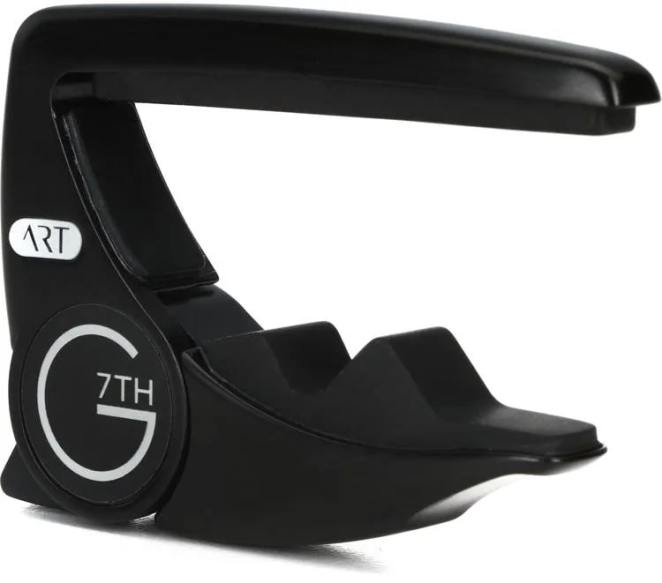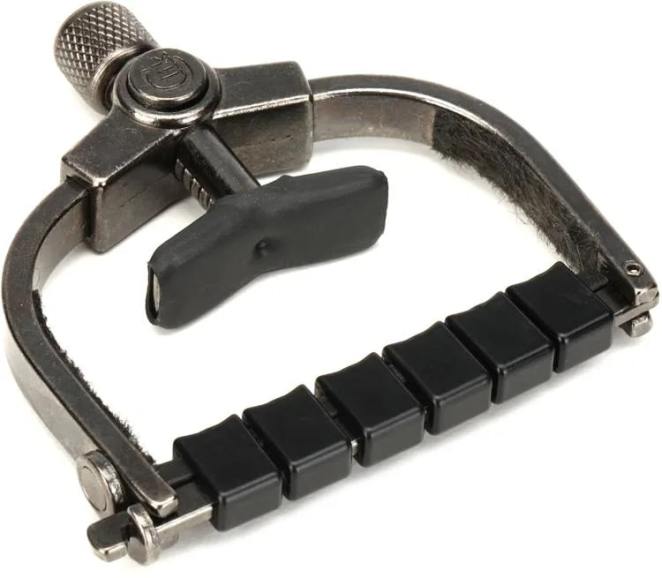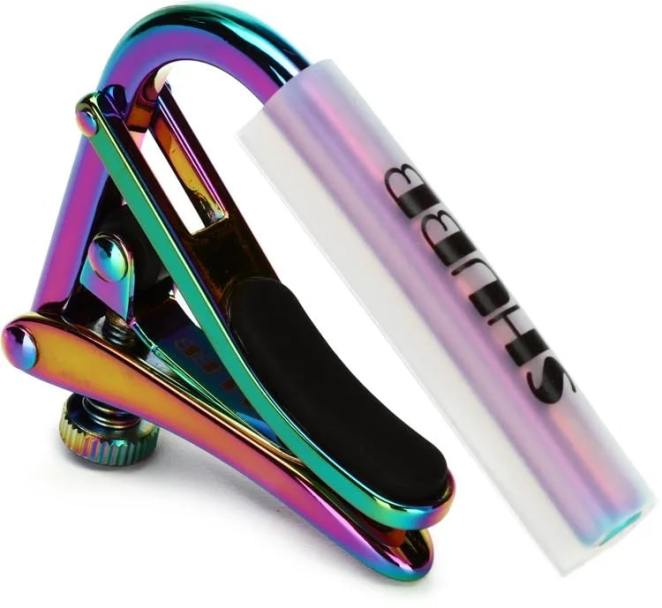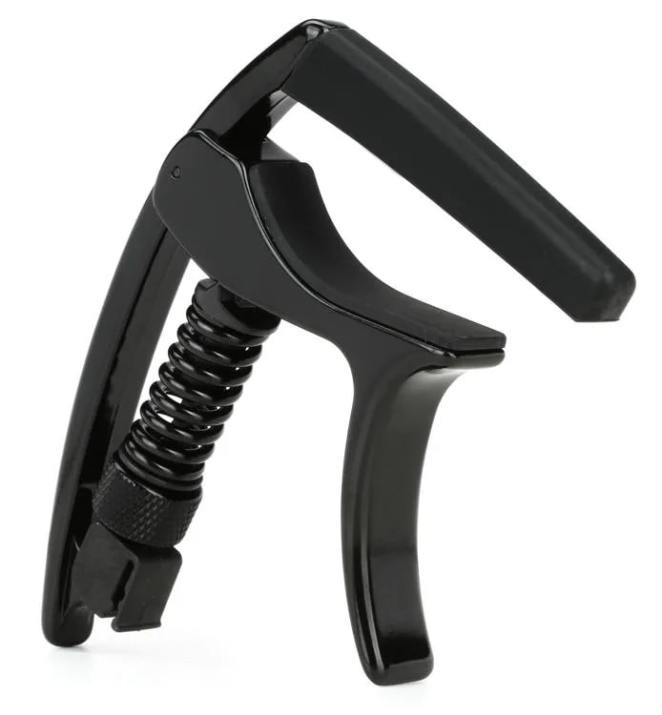When you buy through our links, we may earn an affiliate commission.
Looking for the kind of capo you can count on for gigs and practice?
With a capo in your kit, you can quickly try out all kinds of explorative tonal arrangements that would otherwise require retuning your guitar.
We'll cover some of the best guitar capos on the market, from the most wallet-friendly to the best-looking and beyond.
Our top pick is the G7th Performance 3 Steel String Guitar Capo, which is both durable and flexible.
We've also included a buyer's guide near the end that explains what makes a great capo so great in the first place.
Let's find your next killer capo!
Quick Summary of the Best Guitar Capos
- G7th Performance 3 Steel String Guitar Capo (Best Overall)
- D'Addario NS Capo Lite - Adjustable Tension (Best Budget Capo)
- Kyser Quick-Change Capo (Best Capo for Practice)
- Paige Clik PC-6-ETI 6-string Guitar Capo (Best for Gigs)
- D'Addario NS Artist Capo - Adjustable Tension (Best Front-Mounting Capo)
- Shubb C1P Capo Royale (Best for String Longevity)
- D'Addario NS Tri-Action Capo (Best for Frequent Fret Swaps)
Best Guitar Capos
1. Best Overall – G7th Performance 3 Steel String Guitar Capo

SPECS
- Material: Zinc Alloy
- Radius: Adaptive
- Color Options: Black, Silver, Gold, Celtic, etc.
The G7th Performance 3 guitar capo is at the top of this list for multiple reasons.
Unlike pretty much every other guitar capo on the market, this one benefits from an absolutely awesome adaptive radius feature that makes it a perfect fit for pretty much any standard six-string guitar neck.
Whether you are working with a heavily radiused fretboard or you're used to playing wide, flat fingerboards, the G7th will work equally well as it literally flexes to fit each fretboard's unique shape.
This makes it way easier to keep the tension applied by the capo consistent across all of your instrument's strings.
There's no need to worry about strings being bent way too hard or buzzing from not being pressed hard enough due to your capo's string pad coming with a predefined shape.
Most buyers seem to be pretty pleased with this capo as well, touting its ability to consistently offer great tonal clarity up and down the fretboard as a deciding factor in their purchases.
You should also find the low-profile design to be useful for complex fingerings and tricky chord shapes.
If you want a great, dependable capo that can be used with any of your guitars and is built to last, then the G7th is probably your best bet, hence its position as our best overall.
2. Best Budget Capo – D'Addario NS Capo Lite - Adjustable Tension

SPECS
- Material: Molded ABS plastic
- Radius: Curved
- Color Options: Black
This is the capo to get if you need solid quality on a shoestring budget. D'Addario has knocked it out of the park with the NS Capo Lite, emphasizing simplicity and ease of use above all else while maintaining an outrageous price point below $10.
Although this capo is made of ABS plastic as opposed to most of the pricier metal models on the market, it seems to perform admirably for many guitarists.
The plastic composition doesn't keep this capo from offering a nice adjustable dial feature you can use to get the tension it applies just right. Plus, the NS Capo Lite lives up to its name by being incredibly lightweight - perfect for buskers and traveling musicians.
Those who have used this capo seem particularly ecstatic about its lightweight design and slim profile. Many admit to buying more than one in case they need to swap guitars at a gig or lend one to another player on the spot.
This is one of the best guitar capo deals out there, as it doesn't sacrifice much by way of quality, and it can easily be handled with just one hand.
3. Best Capo for Practice – Kyser Quick-Change Capo

SPECS
- Material: Aluminum
- Radius: Curved
- Color Options: 'Sunburst' in red and amber, abalone, desert camo, black, etc.
For guitarists looking to get a bit of practice in whenever and wherever they can, the Quick-Change Capo offered by Kyser is a high-quality choice.
This is one of the best guitar capos around. Kyser has included everything from a spring-loaded mechanism designed with easy repositioning in mind to strategic padding that prevents neck damage on your instrument.
This capo is made out of aluminum to help it go the distance without being too heavy and comes in a variety of color combinations to match your own aesthetic.
Some users report having exclusively used this type of capo from Kyser for decades with great results. As for the colors, people seem to like matching guitar capos with their electric guitars, but choosing a nice finish is entirely up to you.
These guitar capos clip right onto your guitar's neck with ease, making them much easier to set up in a hurry. You only need one hand to move it up and down the fretboard as well.
Considering how easy these guitar capos are to use, they might even make the cut for performances too.
4. Best for Gigs – Paige Clik PC-6-ETI 6-string Guitar Capo

SPECS
- Material: Steel
- Radius: 16 inch
- Color Options: Black Nickel
The Clik PC-6-ETI offered by Paige might not have the world's most memorable name, but it makes up for that with a wealth of unique features most other capos can't quite match.
First off, this capo offers a completely different design than the others on this list, fitting all the way around your guitar's neck to allow strings to be tensioned from a central position. This makes it easier to get buzz-free tones without over-tensioning or damaging your strings.
The unique tension bar design features individual slots for each string, keeping them all positioned right where you want them as it presses them down and staving off that dreaded detuning effect other capos are guilty of.
This is also the best guitar capo for anyone with a radiused fretboard, as it combines the neat tension bar with a form-fitting radius of its own.
People rave about this capo's ability to keep the strings in tune despite being moved all over the fretboard and readjusted on the fly. These guitar capos are perfect for anyone looking to make their strings last a lot longer overall.
5. Best Front-Mounting Capo – D'Addario NS Artist Capo - Adjustable Tension

SPECS
- Material: Aluminum
- Radius: Curved
- Color Options: Black
This D'Addario guitar capo is a perfect fit for anyone looking for a front-mounting option that they can easily adjust on the fly.
Front-mounting capos like this are designed with their handles facing outward from the fretboard as opposed to being behind the neck.
The NS Artist capo is also built stronger than the other D'Addario on this list, using aluminum instead of plastic to provide better durability overall.
Ergonomic and adjustable down to the micrometer, this is the kind of guitar capo you can count on to get the job done without much fuss.
It also helps out with typical capo woes like strings being detuned or pulled out of position by applying tension horizontally.
Users of this particular guitar capo seem to appreciate the nifty guitar pick holder and the fact that you can fine-tune the tension to fit your needs. Even setting the capo to fairly loose tension seems to do the trick, producing solid tones with no discernible buzz.
You may want to consider this guitar capo if your acoustic guitar or electric guitar has a radiused fingerboard and you like the front-mounted design.
You can easily handle the NS Artist with a single hand, so it could be a great workhorse for accompaniment riffing and more.
6. Best for String Longevity – Shubb C1P Capo Royale

SPECS
- Material: Titanium-Plated Brass
- Radius: Curved or Classical (flat)
- Color Options: Paua Pearl, Rose Gold, and Gold
Shubb's C1P Capo Royale is the kind of capo you might be tempted to choose based on its looks alone, but it offers much more than shiny iridescence.
This capo's super soft rubber pad produces perfect tones under tension, all while protecting your strings from undue wear and tear.
This is one of the best guitar capos for anyone in need of something small too. So you won't end up with a bulging front pocket on your guitar bag when you bring it along.
The Capo Royale leverages over-center locking action to mimic the human hand, keeping all of your strings right where they ought to be when pressed down.
Buyers have clearly been taken in by this capo's beauty and can't seem to stop gushing over it. But, the Capo Royale is solid beneath its glossy exterior, too, as it's made from titanium-plated brass. Chances are that this one will never break on you.
Go for this Shubb if you like a bit of sparkly flair for your fretboard and want to keep your strings from snapping anytime soon.
7. Best for Frequent Fret Swaps – D'Addario NS Tri-Action Capo

SPECS
- Material: Aluminum
- Radius: Curved
- Color Options: Black, Silver
Yet another D'Addario made our list, and for a good reason (or maybe three). Choose this one, and you get the added benefit of its Tri-Action design which makes retuning under tension a thing of the past.
This is one of the best guitar capos from an ergonomics standpoint, boasting a pretty ingenious design that ensures you'll have no trouble at all attaching it to your fingerboard. Plus, there's a pick holder built into it too.
Those who went with this capo confirm it completely eliminates retuning issues and is easy to use for those with sensitive hands.
If you want a solid capo that can accommodate radiused fretboards and guarantee buzz-free results, then this is a great option to consider. It's a sturdy one too. The aircraft-grade aluminum build makes it highly unlikely to break when you need it the most.
Best Guitar Capos Buyer's Guide
Getting the right electric or acoustic guitar capo can be a confusing affair if you're new to these nifty little devices and were not expecting to find so much variety among them. But this buyer's guide will help you sift through the options and find the best fit for your needs.
You'll need to keep a few things in mind:
- Radius and Type
- Materials
- Colors and Aesthetics
Here's why the factors above are worth your consideration:
Radius and Type
The best guitar capos' radiuses correspond to the actual fretboards they are used on. Radiused capos help with overcoming that annoying buzzing sound you get when strings aren't pressed against the frets firmly enough.
Granted, that same buzz might be unavoidable on instruments with particularly low-string action (I'm looking at you, flamenco acoustic guitar makers), but it shouldn't be coming from your capo.
Classical guitars do not benefit from radiused capos as they have totally flat fretboards. A flat capo option like what Shubb's C1P Capo Royale offers is essential for these instruments.
As for types, just about every acoustic guitar capo is bound to offer its own proprietary form factor.
This can make defining general "types" among them challenging, but there are a few common configurations you're bound to come across:
- Trigger capos work a lot like any other kind of clamping tool, allowing you to attach or detach them with a simple squeeze.
- Screw capos allow for tension to be adjusted by way of a screw mechanism. The best guitar capos combine the screw and trigger approach for a balance between ease of use and flexibility.
- Strap capos are a bit less common, but they are certainly out there. These allow you to adjust tension the same way many wristwatches would - by pulling the strap on the underside of the neck to the right notch and securing it in place. Simple but surprisingly effective.
Materials
Each capo manufacturer's choice of materials can have a huge effect on your instrument. As an example, consider the amount of wear a solid steel capo with no padding would cause on the neck of your guitar every time you applied any pressure to it.
Plastic may seem like a sensible choice as it is lightweight and less likely to damage anything, but it has a tendency to deform over time or even break entirely with normal use.
If you choose a metal capo, make sure it comes with the kind of padding that can actually protect your six strings from damage. You should also consider the quality of the material the tension bar is made from, as anything too firm could spell trouble for your strings.
Colors and Aesthetics
Colors can be cool. Cool colors, even more so. If you want to add a little pizzazz to your instrument whenever you clamp on a capo, you'll need to consider the colors it comes in and choose accordingly.
A functional black capo can get the job done, but you can't beat an iridescent, pearly finish or a gold lookalike with Celtic accents.
Frequently Asked Questions (FAQs)
What is the purpose of a guitar capo?
Guitar capos make it possible for players to quickly shorten the length of their instruments' strings. This allows for the same chord shapes to be played in higher keys and substantially lowers string action (the distance between the fretboard and the string) in the process.
With a capo in place on the right fret, you can easily accommodate different singers' voices without having to transpose the entire song to fit further up the fretboard.
Is a guitar capo good for beginners?
A capo can certainly come in handy for beginners. By using a capo, you can play a huge variety of songs without necessarily learning an equally huge variety of chord shapes at every position on the fretboard.
You can learn a handful of basic chords and simply shift your capo's position to play songs in exotic keys. This makes it a great addition to any budding guitarist's arsenal.
Is capo necessary for guitar?
If you just want to pick up your guitar and start playing, then a capo isn't necessary at all. But, if you're looking to learn a lot of different songs as quickly as you can, then a capo can be a great tool to try out.
Your guitar capo can make it much easier to play with other people and stay in key without having a super deep understanding of guitar chord structures or transposing techniques.
In certain cases, some songs are written with a capo in such a way that they become much more difficult to play without one. You'll need a capo to play songs like these.
Why use a capo instead of tuning?
Tuning your guitar differently is always an option if you want to try out some new tonal arrangements, but it isn't necessarily that great of an approach if your main aim is to match a singer's voice or make a high-pitched riff easier to play.
Tuning up an octave can make your guitar's strings feel a lot stiffer under your fingers. A capo can help you accomplish the same thing without hurting your instrument's playability.
In fact, your capo will actually reduce the string action you have to fight against to hit those high notes. Plus, the use of a capo shifts the position of the notes you end up playing with certain chord shapes. This can create unique sounds as the intervals are arranged differently.
What is the disadvantage of capo?
Capos are great for a lot of things, but they are basically guaranteed to limit your access to parts of a guitar's fretboard once they are in place. Unfortunately, that's an unavoidable tradeoff whenever you use a guitar capo.
It can become impossible to play bends or harmonics depending on the type of capo and the fret you place it on. Plus, the normal open string sounds you might like being able to play are not an option with a capo in place, either.
Wrapping Up
Don't stress over finding the perfect capo for your guitar. The process can be as simple as you want it to be.
For a great capo overall, you really are best off getting the G7th Performance 3. But if you want a bit of stylistic flair, something like Shubb's C1P Capo Royale is an awesome option as well.
